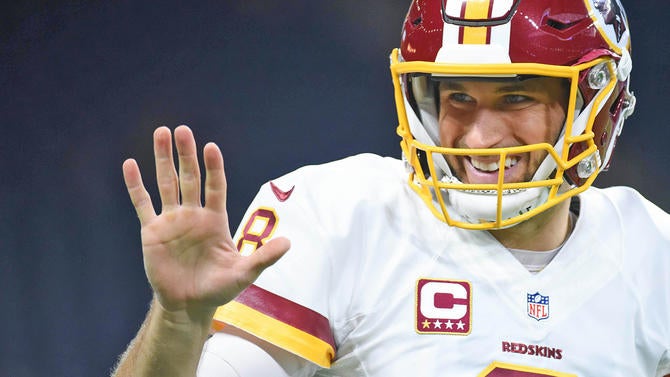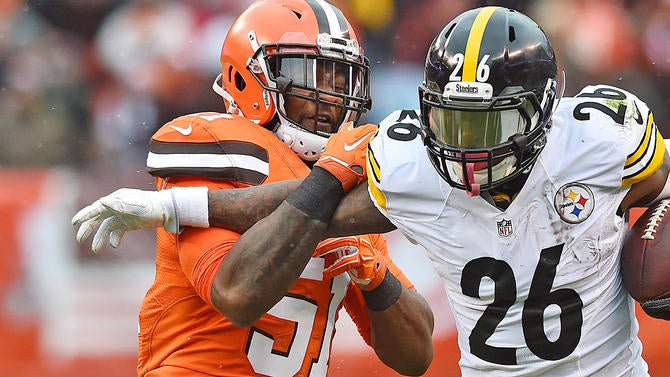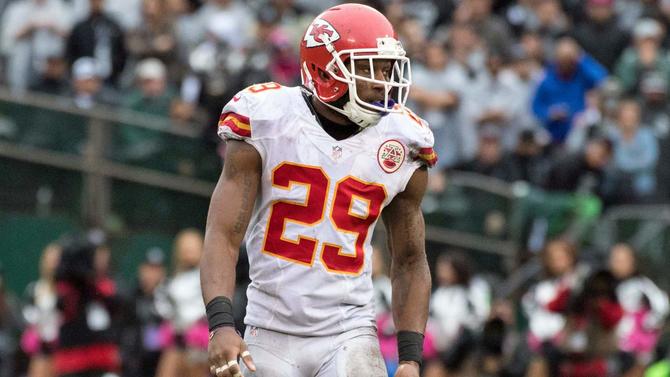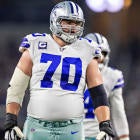Franchise player designations are a blessing for a few players but most view them as a curse. The tag is essentially a high salaried one-year "prove it" deal, which can hinder a player's ability to gain long-term security.
The player must incur the risk of serious injury and poor performance again after already playing out a contract when an agreement on a long-term deal can't be reached. It was a blessing for someone like Redskins quarterback Kirk Cousins. His $19.953 million franchise tag gave him a level of security he didn't have with the approximately $2.6 million he made playing under the four-year rookie contract he received as a 2012 fourth-round pick.
The designation is also a powerful management tool that prevents players from getting fair market value and generally depresses salaries. Although Von Miller became the NFL's highest-paid non-quarterback in July as the Broncos' franchise player on a six-year, $114.5 million contract with $70 million in overall guarantees, it's conceivable that he could have become the NFL's highest-paid player if he had been on the open market like five-time All-Pro defensive tackle Ndamukong Suh was in 2015.
The Super Bowl 50 MVP probably would have had multiple suitors as an unrestricted free agent. The benchmarks Miller could have had a good chance of beating would have been Ravens quarterback Joe Flacco's $22.1 million average per year and Suh's $59.955 million fully guaranteed at signing from the Dolphins.
Some important information about franchise tag logistics is summarized below before revealing the projected 2017 franchise numbers and an examination of the best candidates to receive the designation next year.
What are the different tags again?
NFL teams can retain the rights to one impending free agent in 2017 with the use of a non-exclusive or an exclusive franchise tag during a two-week period from Feb. 15 to March 1.
The 2011 collective bargaining agreement (CBA) changed how non-exclusive franchise tags are determined. Since its inception in 1993, this franchise tag number had been an average of the five largest salaries in the prior year at a player's position or 120 percent of the prior year's salary of the player, whichever was greater. For franchise tag purposes, salary means a player's salary cap number, excluding workout bonuses.
The 120 percent and five largest salaries provisions remain intact but the formula component is now calculated over a five-year period that's tied to a percentage of the overall salary cap. More specifically, the number for each position is determined by taking the sum of the non-exclusive franchise tags as determined by the original methodology for the previous five seasons and dividing by the sum of the actual NFL salary cap amount for the previous five seasons. The resulting percentage, which is known as the Cap Percentage Average in the CBA, is then multiplied by the actual salary cap for the upcoming league year.
This non-exclusive tag allows a player to negotiate with other NFL teams but if he signs an offer sheet with another club, his team has five days to match the offer. If the offer is not matched, his team will receive two first-round picks as compensation from the signing team.
Under the exclusive franchise tag, a player will receive a one-year offer from his team that is the greater of the average of the top five salaries at his position once the restricted free agent signing period of the current year has ended (April 21 for 2017) or 120 percent of his prior year's salary. A player cannot negotiate with other teams with the exclusive franchise tag.
Teams also have the option to use a transition tag instead of a franchise tag. The transition tag operates similarly to the non-exclusive franchise tag, except it is based on the average of the top 10 salaries at a player's position. Teams have the same matching rights as with franchise tags but do not receive any draft choice compensation.
2017 franchise tag projections
The chart below contains an early look at the 2017 franchise tags. I keep track of the salary data necessary to do the calculations under the franchise tag formula. I recently confirmed with my NFL sources the 2016 data. The franchise tags are preliminary because the numbers can't be finalized until the 2017 salary cap is set in late February or early March.
$168 million is being used for the 2017 salary cap because it is an 8.2 percent increase, which is consistent with the 8.37, 8.13 percent and 7.73 percent growth in the salary cap in each of the past three years.
| Position | Current | Projected | % Change |
| Cornerback | $13,952,000 | $14,297,000 | 2.47% |
| Defensive End | $15,701,000 | $16,955,000 | 7.99% |
| Defensive Tackle | $13,615,000 | $13,468,000 | -1.08% |
| Linebacker | $14,129,000 | $14,754,000 | 4.42% |
| Offensive Line | $13,706,000 | $14,444,000 | 5.38% |
| Punter/Kicker | $4,572,000 | $4,863,000 | 6.36% |
| Quarterback | $19,953,000 | $21,395,000 | 10.02% |
| Running Back | $11,789,000 | $12,377,000 | 4.99% |
| Safety | $10,806,000 | $10,961,000 | 1.43% |
| Tight End | $9,118,000 | $9,894,000 | 8.02% |
| Wide Receiver | $14,599,000 | $15,826,000 | 8.4% |
Note: Projections assume 2017 salary cap is $168 million.
The good thing for players is teams are becoming more judicious in using franchise player designation as the cost rises. A record twenty-one players were franchised in 2012, including six kickers and punters, in the first year of the new method of calculation when there was almost a 20 percent drop in the franchise tags from 2011. An average of 6.5 players per year has received the designation in the four years (2013-2016) since the first year of the change.
Best 2017 candidates to get the tag
Several players that would have received or been good candidates for franchise tags in 2017 have already signed contract extensions. These include Colts quarterback Andrew Luck, Saints quarterback Drew Brees, Cardinals defensive back Tyrann Mathieu, Eagles defensive tackle Fletcher Cox, Vikings safety Harrison Smith, Packers offensive tackle David Bakhtiari, Seahawks wide receiver Doug Baldwin and Lions cornerback Darius Slay.
The Cowboys and Jets aren't in a salary cap position to use the designation. Dallas has the most 2017 salary cap commitments in the NFL at $176.9 million with 47 players under contract and just $2.65 million of unused cap space that can be carried over to next year. The Cowboys project to be almost $9 million over the expected 2017 cap limit using offseason cap accounting rules. The Jets have $168.1 million in 2017 cap commitments with 49 players under contract and less than $1 million of cap room to carry over from this season. Neither team has an impending free agent that should be seriously considered for a franchise tag.
There are a few other teams that will have good players with expiring contracts who aren't quite franchise tag-worthy. Bengals offensive tackle Andrew Whitworth is still performing at a high level but is 35 years old. Outside linebacker Nick Perry has a career high eight sacks. Players that Green Bay wants to retain typically don't make it out of town even if they reach free agency. A.J. Bouye has quietly developed into one of the NFL's better cornerbacks but the Texans will likely let him test the open market before making the type of one-year commitment required by the franchise tag. Bills cornerback Stephon Gilmore seemed destined for a franchise tag prior to the start of season. It seems unnecessary now since he has been struggling with inconsistency this season.
Cousins playing on his $19.95 million non-exclusive franchise tag was a no-brainer considering Washington's reported best offer was $16 million per year with $24 million in guarantees. Barring a serious injury or Cousins turning into Brock Osweiler down the stretch of the regular season, he should get a big payoff in 2017 for his bet on himself.
Cousins is on pace for 5,149 passing yards. Only Tom Brady, Drew Brees and Peyton Manning have had more in a season. It would be the best single-season total for a quarterback under the age of 30. Cousins isn't just amassing a lot of passing yards. He is also in the NFL's top 10 in touchdown passes (20, tied for ninth), passer rating (101.4, sixth), completion percentage (68.4, fourth) and yards per pass attempt (8.1, fourth).

CBS Sports NFL Insider Jason La Canfora first reported that the Redskins plan to franchise Cousins for a second time in 2017 at $23,943,600, which is 20 percent more than this year's tag, if a long-term deal can't be reached before the beginning of March. The 2017 tag would likely be the exclusive version because the cost is expected to be practically the same as the non-exclusive one.
Regardless of whether the Redskins return to the playoffs for a second straight year, Cousins will be looking for a deal in the same ballpark as Luck's five-year, $122.97 million extension which reset the NFL pay scale. Luck's deal averages $24.594 million per year and contains $87 million in guarantees ($47 million fully guaranteed at signing). The Raiders' Derek Carr and the Lions' Matthew Stafford are likely to get at least $25 million per year if they receive extensions next offseason.
Bell is arguably the NFL's best dual-threat running back when healthy. His 2015 season was cut short by a torn MCL and PCL in his right knee which occurred during a Week 8 game against the Bengals. He began this season serving a three-game suspension for violating the NFL's substance abuse policy, which is his second drug suspension in as many years.
Bell could be the litmus test for high-end running back compensation in a declining market. With the retirement of Marshawn Lynch from the Seahawks, Adrian Peterson is the NFL's only $10 million-per-year running back. There may not be any by the time the 2017 league year begins next March. Peterson is scheduled to make $18 million in 2017, the final year of his contract. The 31-year-old veteran will need to renegotiate his contract to be more in line with the rest of the running back market in order to remain with the Vikings next season and beyond.

Placing a transition tag on Bell could also be an option. The number should be in the $10.15 million neighborhood. A transition tag would come with some risk because the Steelers would only get a right to match an offer sheet from another team instead of two-first round picks as compensation if they opt not to match. The Steelers have been one of the biggest proponents of the seldom-used transition tag, applying it to offensive tackle Max Starks in 2008 and linebacker Jason Worilds in 2014.
Given the state of the running back market, Bell's drug suspension and injury history, there's no guarantee the 24-year-old would attract an offer sheet exceeding the maximum value of the five-year extension that Steven Jackson signed with the St. Louis Rams in 2008, which was approximately $49 million ($9.8 million per year).
The Cardinals will have a lot of work to do before free agency starts to keep the core of their defense intact. Defensive end Calais Campbell and safety Tony Jefferson, who is having a breakout year, will also be free agents.
Jones, who was acquired in March from the Patriots for a 2016 second-round pick (61st overall) and guard Jonathan Cooper (seventh overall pick in the 2013 draft), is the best edge rusher Arizona has had in quite some time. He has eight sacks this season. By demonstrating that his pass-rushing ability is transferrable to a different defensive scheme, Jones is putting himself in line to get a deal comparable to the five-year, $85 million contract with $52.5 million in guarantees that Olivier Vernon received from the Giants as a free agent.
The Patriots made a surprising move as the Nov. 1 trading deadline approached by dealing Collins to the Browns. In return, the Patriots receive a conditional 2017 compensatory third-round pick that could decrease to a 2018 fourth-round pick under certain conditions. Collins, an All-Pro in 2015, instantly became the best defensive player on a team devoid of talent in the midst of a rebuilding process.

The Browns are capable of handling a franchise tag better than any team in the NFL because they are projected to have more than $110 million of cap room in 2017. Look for Collins to try to set a new standard for linebackers who aren't considered pass rushers. Luke Kuechly is the current benchmark with the five-year extension he received from the Panthers in 2015 averaging $12,359,059 and containing $34,363,324 in guarantees.
Bennett, who was acquired from the Bears along with a 2016 sixth-round pick in March for a 2016 fourth-round pick, was invaluable while quarterback Tom Brady started the season serving his four-game suspension relating to Deflategate and Rob Gronkowski was recovering from a hamstring injury in September. He was a top priority in the passing game.
Gronkowski's inability to stay healthy may have the Patriots thinking about reviving the dual high-priced tight end concept, which was the long-term plan a few years ago. It's viable since the Patriots don't have a significant investment in wide receivers and should have over $60 million in cap room next year. Gronkowski and Aaron Hernandez were the NFL's two highest-paid at the position by average yearly salary in 2012.
Hightower could be the beneficiary of the Collins trade because of his increased contract leverage. Letting Collins go means there's more urgency for New England to retain him. He is essentially everything Jerod Mayo, who retired after last season, used to be for the Patriots before injuries diminished his effectiveness.
Mayo got a five-year, $48.5 million extension (which included $27 million in guarantees) toward the end of the 2011 season when the salary cap was $120.375 million. The Patriots are likely going to have to do better than that with Hightower since it is a five-year old deal. An equivalent contract to Mayo's in a 2017 salary cap environment will average approximately $13.5 million per year with slightly more than $37.5 million in guarantees.
A deal should be able to be struck between the two data points considering Collins reportedly turned down $11 million per year from the Patriots before the regular-season started. If Collins signs a deal with Cleveland, it will be particularly relevant to Hightower's camp since the Patriots obviously value him more.
The expectation was that the five-year, $51.25 million extension Harrison Smith signed with the Vikings last June would pave the way for a deal with Berry before the July 15 multiyear contract deadline for franchise players. Tyrann Mathieu's five-year extension averaging $12.5 million per year after the deadline will be an additional hurdle to signing Berry long term.

Berry's camp will view Mathieu's contract as the new benchmark for safeties over Smith's instead as a hybrid defensive back deal. A second franchise tag for Berry will be $12,967,200, which is 120 percent of his current $10.806 million franchise tender.
Short didn't sign an extension before the regular season started because general manager Dave Gettleman was uncomfortable paying the going rate for pass-rushing interior defensive lineman established by Fletcher Cox and Muhammad Wilkerson. That rate is $50 million to $60 million in guarantees on a deal averaging more than $17 million per year. Gettleman's feelings may not have changed since Short hasn't been as consistent as he was during his 2015 breakout campaign in which he tied for the NFL lead among interior defensive linemen with 11 sacks.
Jeffery is playing on his $14.599 million franchise tag because the Bears were unwilling to give him a contract comparable to Dez Bryant, Demaryius Thomas, Julio Jones and A.J. Green. These deals, which were signed in 2015, average between $14 million and $15 million per year. With the exception of Green, the players received between $43.5 million and $47 million of guarantees in their contracts.

The four-game suspension without pay that Jeffery is currently serving for violating the NFL's performance-enhancing drugs (PED) policy won't affect the 20 percent increase associated with the Bears using a second franchise tag on him. Since it will still be based on his full $14.599 million tag amount, franchising Jeffery again will be $17,518,800. Jeffery will likely be the best wide receiver available despite the PED suspension if he hits the open market.
Pierre-Paul is returning to the form he displayed in 2014 before severely injuring his right hand during a 2015 Fourth of July fireworks accident after receiving a $14.8 million franchise tag four months earlier. He returned to the Giants this season on a one-year, $10 million deal after the accident limited him to one sack in the eight games he played in 2015. According to Pro Football Focus, Pierre-Paul is 10th in the NFL this season with 53 quarterback pressures (combined sacks, quarterback hurries and quarterback hits). By comparison, the Giants' high priced free agent defensive end signee Olivier Vernon ($17 million per year and $52.5 million in guarantees) is fifth in the NFL with 57 pressures.
Johnson and the Rams didn't make much progress on a long-term deal after he was given a $13.952 million franchise tag over fellow cornerback Janoris Jenkins. Although Jenkins is having a better season than Johnson, the Rams will have a hard a time convincing him to take less than the five-year, $62.5 million contract ($12.5 million per year) with $28.8 million fully guaranteed that his former counterpart got from the Giants. That's because he could be the best cornerback in free agency if the Rams don't use another franchise tag on him for $16,742,400.
Ingram had a breakout season in 2015 with 10.5 sacks. He currently has six sacks so consecutive double-digit sack seasons is within reach. Ingram is likely going to want to be paid the premium that accomplished edge rushers in their mid-to-late 20s typically receive, which may be too rich for San Diego's blood.




































